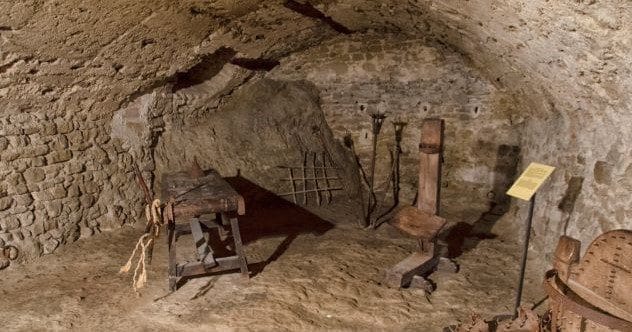While modern correctional facilities often face criticism, medieval prisons were truly horrifying. Some aspects of incarceration were surprisingly inhumane. From humiliation to torture, here are 10 shocking things about medieval prisons.
Creepy Locations
Unlike today’s prisons, medieval prisons were in basements, town towers, or castle dungeons. These facilities were dark, dirty, and moldy.
Prisoners were chained to walls or left in holes. Abbeys also housed prisons for disobedient monks. The first dedicated prison buildings in Britain weren’t built until the twelfth century. [1]
Torture
Torture was common in medieval prisons to force confessions. The Judas Cradle, a torture chair, was one horrifying device. Prisoners spent hours on this triangle-shaped chair, with the sharp tip forced into their body.
The rack, used in the Tower of London, dislocated joints to get confessions from those suspected of heresy or treason. [2]
Slavery
In the early Middle Ages, prisoners often became enslaved. This wasn’t just for cheap labor but for social control and to deter crime.
Enslaving prisoners of war dates back to Ancient Greece. Captured pirates and POWs were frequently enslaved. [3]
Food
Before the 19th century, British prisoners had to pay for their own food, a major income source for warders. Prices varied by rank; aristocrats paid more than commoners, with lords paying the most.
Food ranged from nutritious meals to gruel. Charities or families sometimes provided food, but jailers weren’t obligated to feed inmates who didn’t pay. Those refusing to enter a plea received only bread and water or were starved. [4]
Crimes that Warranted Jail Time
Medieval prisons were rare due to the expense; communities preferred mutilation or execution. Surprisingly, some serious crimes had mild penalties, like a fine for murder in Britain.
Unpaid debt led to imprisonment. Violating the Assize of Bread and Ale, which controlled bread and ale prices, could result in confinement. Playing medieval football, a violent game, could lead to six days in prison. [5]
The Pillory
In medieval York, imprisonment held suspects until trial, which could take up to ten years. Punishment included the pillory or stocks, meant to publicly humiliate lawbreakers.
Prisoners were displayed in the market with their head and hands confined, enduring taunts. This was used for moral and political crimes, like dishonest trading. People threw rotten food at them, and some were nailed to the frame. [6]
Special Categories of Prisons
Unique prisons existed, like a forest prison in York for violating forest rules. Hunting deer in the royal forest had harsher penalties: castration and blinding.
Prisons for clergymen were preferable, enticing accused criminals to claim clergy status for lenient treatment. Castles also housed prisons, often in gatehouses. [7]
Lack of Isolation from the Community
Medieval prisons weren’t isolated; prisoners mixed with the community. Prostitutes were even smuggled in.
Inmates could come and go. Guy Geltner’s book, The Medieval Prison, describes interactions between incarcerated people and society in Italian cities like Bologna, Florence, and Venice, where most inmates weren’t locked up. [8]
Ways to Get Out of Prison
Early release depended on interesting criteria. “Prisoner offerings” in Italy were charitable acts tied to religious feast days, with released prisoners seen as offerings to the patron saint.
Paying ransom also secured release. Private imprisonment for debt or disputes required relatives to pay for freedom. Prisoners of war were often held for ransom. [9]
Self-Imprisonment
In the 11th and 12th centuries, many chose to be walled up in a cell for life. The Anchoritic life involved withdrawing from society for prayer and asceticism, according to The Collector website.
Unlike prisoners, anchorites volunteered, driven by religious devotion. Once inside, there was no return; they were considered dead to the world. This practice, an early form of monasticism, arose from the church’s attempt to control potential heresy. Locals provided food and care. [10]
Medieval prisons were indeed shocking. From torture and enslavement to unique forms of punishment and even self-imprisonment, life in these institutions was markedly different from today.
Leave your comment below to share your thoughts on these shocking facts!










